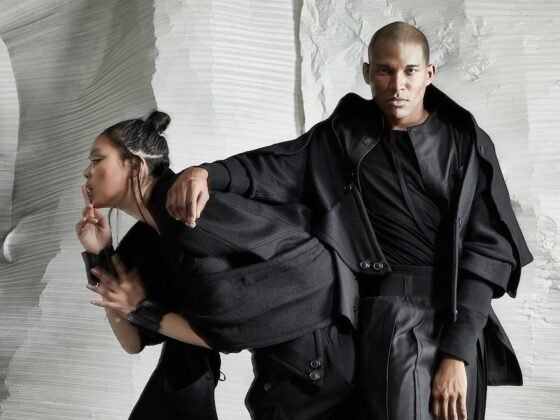Fashion is a dynamic and ever-evolving industry, marked by an intricate dance of trends that continuously shape and reshape the way we express ourselves through clothing. The concept of fashion cycles refers to the recurring patterns and trends that emerge, fade away, and then resurface over time. Understanding these cycles is like unraveling the threads of a rich tapestry, revealing the complex interplay between history, culture, and individual expression.
The Birth of Trends
Fashion cycles often begin with a spark of innovation, whether it’s a groundbreaking design, a cultural movement, or a societal shift. Designers and influencers act as catalysts, propelling new ideas onto the runway and into the public consciousness. As these fresh concepts gain traction, they become the focal point of the fashion landscape, defining a particular era or season.

The Rise and Peak
Trends, like waves, gradually gain momentum until they reach their zenith. During this phase, the trend is omnipresent—seen on runways, embraced by celebrities, and adopted by mainstream culture. Fashion enthusiasts eagerly incorporate these trends into their wardrobes, and the cycle becomes a collective expression of the current zeitgeist.
However, the very nature of fashion cycles dictates that the zenith is temporary. What was once novel and cutting-edge inevitably becomes commonplace, leading to the next phase of the cycle.
The Decline and Hibernation
As quickly as trends rise to prominence, they begin their descent into obscurity. What was once the epitome of style starts to feel tired and overdone. The market becomes saturated, and consumers yearn for something new and different. Fashion cycles dictate that trends must make way for innovation, prompting designers to explore new territories and consumers to seek fresh modes of self-expression.
This decline doesn’t mean the end of a trend; rather, it signals a period of hibernation. Styles may fade from the mainstream, but they linger in the background, waiting for their inevitable resurgence.
Revival and Reinterpretation
One of the most fascinating aspects of fashion cycles is the cyclical nature of trends. What was once considered passé reemerges with a renewed sense of relevance. Designers and fashionistas draw inspiration from the past, reinterpreting and revitalizing styles for contemporary tastes.
This revival often involves a blend of nostalgia and modernity, creating a sense of familiarity with a contemporary twist. As a result, trends that were once relegated to the archives find themselves back in the limelight, captivating a new generation of fashion enthusiasts.
The Impact of Technology and Globalisation
In the digital age, fashion cycles have been accelerated and amplified by technology and globalisation. Social media, in particular, plays a pivotal role in disseminating trends at lightning speed. What starts as a niche style can quickly become a global phenomenon, reaching every corner of the world in a matter of moments.
This rapid dissemination, while exciting, also poses challenges for the sustainability of fashion. The “fast fashion” culture that emerged in recent years is characterized by the rapid production of inexpensive, trendy clothing. As a result, the life span of trends has shortened, contributing to environmental concerns and ethical considerations within the industry.

Here are some of the problems caused by fashion cycles:
- Fast Fashion and Environmental Impact: One of the most pressing issues associated with fashion cycles is the rise of fast fashion. The rapid turnover of trends encourages the mass production of inexpensive clothing, leading to environmental degradation. The fashion industry is a significant contributor to pollution, waste, and resource depletion, as garments are often discarded quickly, filling landfills with non-biodegradable materials.
- Consumerism and Overconsumption: Fashion cycles fuel a culture of consumerism, where individuals feel pressured to constantly update their wardrobes to stay on trend. This overconsumption not only strains personal finances but also contributes to the broader environmental problems associated with manufacturing, transportation, and disposal of clothing.
- Ethical Concerns in Production: The demand for rapidly produced, affordable fashion has led to ethical concerns in the production process. Sweatshops and exploitative labor practices are prevalent in some parts of the world where garments are manufactured, leading to issues such as low wages, poor working conditions, and child labor.
- Waste and Disposal Issues: The disposable nature of fast fashion contributes to a significant waste problem. Clothing that falls out of trend quickly becomes discarded, adding to the already substantial amount of textile waste. Proper recycling and disposal of clothing are often neglected, exacerbating the environmental impact.
- Cultural Appropriation: Fashion cycles sometimes involve the appropriation of elements from different cultures without proper acknowledgment or understanding. This can lead to the commodification of cultural symbols and traditions, resulting in offense and the dilution of cultural significance.
- Negative Impact on Body Image: The constant influx of new trends can create unrealistic beauty standards, promoting a narrow and often unattainable definition of beauty. This can lead to body image issues, low self-esteem, and a sense of inadequacy among individuals who may feel pressured to conform to these standards.
- Unsustainable Production Practices: The pace of fashion cycles can lead to unsustainable production practices, with brands cutting corners to meet tight deadlines. This may involve the use of environmentally harmful materials, excessive water consumption, and other practices that compromise the long-term health of ecosystems.
- Lack of Diversity in Representation: Fashion cycles have historically been criticized for a lack of diversity in representation, both in terms of the models chosen to showcase designs and the designers creating them. This lack of diversity perpetuates stereotypes and limits the industry’s ability to embrace and celebrate the richness of global cultures.
Addressing these problems requires a collective effort from consumers, industry stakeholders, and policymakers. A shift towards sustainable and ethical practices, increased transparency, and a more mindful approach to consumption are crucial steps in mitigating the negative impacts of fashion cycles.











